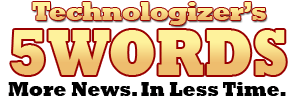 Like 5Words? Subscribe via RSS.
Like 5Words? Subscribe via RSS.
Sony adopts standard e-book format.
Obligatory Apple tablet rumor story.
Snow Leopard: later this month?
The Pre and location awareness.
Samsung’s cameras have two LCDs.
 Like 5Words? Subscribe via RSS.
Like 5Words? Subscribe via RSS.
Sony adopts standard e-book format.
Obligatory Apple tablet rumor story.
Snow Leopard: later this month?
The Pre and location awareness.
Samsung’s cameras have two LCDs.
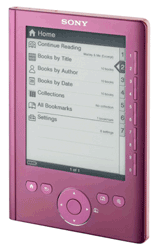 If Sony is a bit nonplussed over all the attention for Amazon’.coms Kindle, it’s understandable. The Japanese consumer-electronics behemoth beat Amazon to market with e-book readers that share much of the Kindle’s appeal and technology, and their current touchscreen model arguably has a better interface than the Kindle 2. (Of course, the Kindle benefits hugely from its wireless connection and large selection of new books.)
If Sony is a bit nonplussed over all the attention for Amazon’.coms Kindle, it’s understandable. The Japanese consumer-electronics behemoth beat Amazon to market with e-book readers that share much of the Kindle’s appeal and technology, and their current touchscreen model arguably has a better interface than the Kindle 2. (Of course, the Kindle benefits hugely from its wireless connection and large selection of new books.)
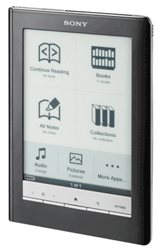 Now Sony’s striking back with a couple of interesting new e-readers–including one called the Reader Pocket Edition (seen at left) that has a five-inch e-ink screen and a $199 pricetag, $100 less than the Kindle 2. Its very name pitches it as being pocketable; I haven’t seen one in person, but I’m guessing that the five-inch display means it’ll be a tight fit in a shirt pocket. (The pocket-filling iPhone has a 3.5-inch screen).
Now Sony’s striking back with a couple of interesting new e-readers–including one called the Reader Pocket Edition (seen at left) that has a five-inch e-ink screen and a $199 pricetag, $100 less than the Kindle 2. Its very name pitches it as being pocketable; I haven’t seen one in person, but I’m guessing that the five-inch display means it’ll be a tight fit in a shirt pocket. (The pocket-filling iPhone has a 3.5-inch screen).
I’ll be intrigued to see if a relatively cheap, relatively small e-reader will appeal to folks who haven’t splurged on a Kindle. It’s true that iPhones and iPods Touch already make pretty pleasing e-readers thanks to apps like Kindle for iPhone and Eucalyptus, but the Pocket Edition’s screen is larger and its E-Ink display should let it run for days on a charge.
Sony is also announcing the Reader Touch Edition (at right), a touchscreen model which matches the Kindle’s six-inch screen and $299 price, but doesn’t have wireless. (Sony told ZDnet that it’s working on a wireless device.) It’s also matching Amazon’s price of $9.99 for bestsellers and new releases–down from $11.99–and touting its million-book library, although that figure includes a lotta public-domain tomes from Google.
People keep treating the Plastic Logic reader as the Kindle’s principal rival, and maybe it will be, once it stops being vaporous (it’s due sometime next year). For now, though, it’s really an Amazon-Sony battle–and it’s nice to see Sony coming back for more.
Are you any more interested in a $199 five-inch Sony e-reader (sans wireless) than in a $299 six-inch Amazon one?
 Novelist Nicholson Baker is an unapologetic friend of paper–and his book Double Fold* is an important expose of the mass dumping of bound newspaper volumes by libraries in favor of vastly inferior microform copies. So you gotta think that when The New York arranged for him to write about Amazon.com’s Kindle, it knew that it wasn’t going to get a love letter. It didn’t—but “A New Page” is as eloquent a bad review of the Kindle as you’re going to find. Even if you find much more value in the Kindle than Baker does, as I do, you may find yourself nodding as he makes the case for print and ticks off all of the Kindle’s downsides.
Novelist Nicholson Baker is an unapologetic friend of paper–and his book Double Fold* is an important expose of the mass dumping of bound newspaper volumes by libraries in favor of vastly inferior microform copies. So you gotta think that when The New York arranged for him to write about Amazon.com’s Kindle, it knew that it wasn’t going to get a love letter. It didn’t—but “A New Page” is as eloquent a bad review of the Kindle as you’re going to find. Even if you find much more value in the Kindle than Baker does, as I do, you may find yourself nodding as he makes the case for print and ticks off all of the Kindle’s downsides.
Other than…well, me, Baker is one of the few Kindle judges I’ve seen who doesn’t buy Amazon’s “reads like real paper” claims for the device’s E Ink screen:
The problem was not that the screen was in black-and-white; if it had really been black-and-white, that would have been fine. The problem was that the screen was gray. And it wasn’t just gray; it was a greenish, sickly gray. A postmortem gray. The resizable typeface, Monotype Caecilia, appeared as a darker gray. Dark gray on paler greenish gray was the palette of the Amazon Kindle.
Baker also points out rightly that the presentation of newspapers–at least all the ones I’ve seen–on the Kindle is pretty pathetic. It’s not just that they aren’t well done; they’re nowhere near as well done as they could be even considering the Kindle’s limitations.
Like me, Baker isn’t so sure that the conventional wisdom that an LCD screen such as that on the iPhone is harder on the eyeballs than E Ink is true. Actually, he’s pleased with the iPod/iPhone Touch version of Kindle as a way to quickly dip into a snippet of a book.
So am I–enough so that I’m flirting with the idea of selling my Kindle 2, since I do most of my Kindle reading on the go on my iPhone these days. I’ll let you know if end up parting with it.
*footnote: Baker’s takedown of the Kindle is available on the Kindle, which lets you subscribe to The New Yorker. And Double Fold (subtitle: “Libraries and the Assault on Paper”) is available as a Kindle book, too. In fact, Amazon seems to really want you to buy it in that form:
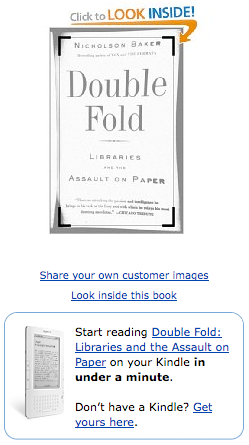
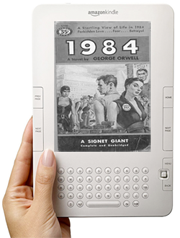 Amazon’s decision to remotely delete pirated copies of George Orwell’s 1984 and Animal Farm from customers’ Kindle e-readers and refund their money was stupid, thoughtless, and self-inflicted. That’s not an irate blogger talking–it’s Amazon.com founder Jeff Bezos, who indulged in some serious self-flagellation at the company’s forums, as reported by TechCrunch’s MG Siegler.
Amazon’s decision to remotely delete pirated copies of George Orwell’s 1984 and Animal Farm from customers’ Kindle e-readers and refund their money was stupid, thoughtless, and self-inflicted. That’s not an irate blogger talking–it’s Amazon.com founder Jeff Bezos, who indulged in some serious self-flagellation at the company’s forums, as reported by TechCrunch’s MG Siegler.
Bezos’s mea culpa is one of the most refreshingly humble statements I’ve ever seen from a tech company CEO. But it’s pretty much standard that examples of major tech companies making boneheaded DRM-related decisions are followed up by backpedaling and apologies. If other companies remembered that, they’d make fewer boneheaded decisions in the first place and spend less time apologizing. Sounds like a win for everybody involved.
Here’s Bezos’s post in its entirety:
This is an apology for the way we previously handled illegally sold copies of 1984 and other novels on Kindle. Our “solution” to the problem was stupid, thoughtless, and painfully out of line with our principles. It is wholly self-inflicted, and we deserve the criticism we’ve received. We will use the scar tissue from this painful mistake to help make better decisions going forward, ones that match our mission.
As far as I know, Amazon hasn’t said what it intends to do in future instances of publishers selling pirated books through Kindle–a situation that’ll surely happen again, and one which copyright holders have a right to be upset about. But maybe part of the solution lies in figuring out better measures to prevent the stolen goods from getting into Amazon’s virtual bookstore in the first place.
![]() At the moment, “e-book” and “Kindle” are darn near synonymous. Barnes & Noble aims to change that with multiple announcements it made today. It’s releasing free e-reader applications for Windows, Mac OS X, iPhone, and BlackBerry; it’s opened an e-bookstore with 700,000 titles, including bestsellers for $9.99 apiece; and it’s announced a deal that will make it the exclusive e-bookstore for Plastic Logic’s e-reader, due in 2010.
At the moment, “e-book” and “Kindle” are darn near synonymous. Barnes & Noble aims to change that with multiple announcements it made today. It’s releasing free e-reader applications for Windows, Mac OS X, iPhone, and BlackBerry; it’s opened an e-bookstore with 700,000 titles, including bestsellers for $9.99 apiece; and it’s announced a deal that will make it the exclusive e-bookstore for Plastic Logic’s e-reader, due in 2010.
B&N is saying that its e-bookstore’s 700,000 digital books makes it the largest electronic bookstore (Amazon’s Kindle store has 300,000 books). But it’s also touting more than half a million free public-domain works provided by Google Books. That seems to leave it with fewer examples of recent, copyrighted stuff than Amazon: When I checked the New York Times’ top five bestsellers in hardcover fiction, hardcover nonfiction, paperback trade fiction, and hardcover advice, Amazon had all but one in Kindle format, and B&N had only half. But B&N is superambitious: “The company expects that its selection will increase to well over one million titles within the next year, inclusive of every available eBook from every book publisher and every available eBook original, which is a fast growing marketplace.”
I tried the iPhone and OS X editions of the e-reader software (which are based on the existing apps from B&N subsidiary Fictionwise), and found them to be a mixed bag. On the plus side, the iPhone version has some features that Amazon’s Kindle for iPhone doesn’t, including the ability to choose fonts and opt for justified or unjustified text. But there’s nothing like Amazon’s Whispersync, which keeps track of your place in a book as you move between devices. And B&N’s iPhone-friendly site for finding and buying e-books isn’t as good as Amazon’s: If you know what you’re looking for you can search for it, but you can’t even pull up a list of bestsellers to browse through.
And when I wanted to download one of the free Google Books tomes, I was flummoxed by the process: The B&N site couldn’t decide whether the book was free or cost a penny, and demanded my credit-card information even though the total price was $0.00.
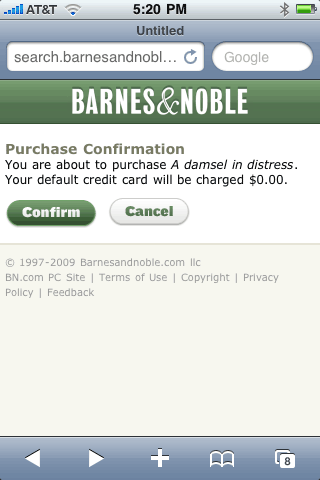
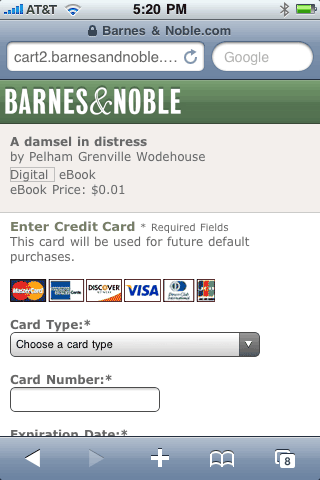
Both B&N and Amazon make you use the iPhone’s Safari if you want to buy books on your phone; I’d much rather they let you do so from within the apps themselves. iPhone OS 3.0’s in-app commerce would let them do that, but they’d have to give Apple a cut of proceeds, so I’m not holding my breath.
All in all, Barnes & Noble’s e-book initiative seems rougher around the edge’s than Amazon’s–which isn’t surprising given that the latter has almost a two-year head start. B&N won’t truly compete head-to-head with the Kindle until the Plastic Logic reader is finally on sale next year, so it’s got some time to refine this first rough draft. I’d love to see Amazon get some serious competition, and long-term, B&N seems to be in as good a position as anyone to provide it.
 [IMPORTANT UPDATE: The Web is rife with examples of people assuming something unlikely-sounding is true because they read it somewhere. I usually go to pains to avoid doing so–which is why my posts tend to be rife with words like “reportedly” and “allegedly”– but in this post I screwed up. As BetaNews reports–rightly taking me to task–everyone who ranted about this was missing one important detail: The Orwell books that Amazon yanked back were unauthorized copies of copyrighted works. You can argue whether it’s OK to delete even pirated copies–Amazon appears to have done a poor job of communicating what it was doing, and now says it won’t repeat its actions. But this wasn’t about whims; it was about Amazon unwittingly serving as a channel for stolen goods. I now return you to my original post.]
[IMPORTANT UPDATE: The Web is rife with examples of people assuming something unlikely-sounding is true because they read it somewhere. I usually go to pains to avoid doing so–which is why my posts tend to be rife with words like “reportedly” and “allegedly”– but in this post I screwed up. As BetaNews reports–rightly taking me to task–everyone who ranted about this was missing one important detail: The Orwell books that Amazon yanked back were unauthorized copies of copyrighted works. You can argue whether it’s OK to delete even pirated copies–Amazon appears to have done a poor job of communicating what it was doing, and now says it won’t repeat its actions. But this wasn’t about whims; it was about Amazon unwittingly serving as a channel for stolen goods. I now return you to my original post.]
This is hysterical and depressing, all at the same time: Everybody who’d bought George Orwell’s 1984 and Animal Farm for their Amazon Kindle e-book readers have had their copies yanked back by Amazon and received a refund. The books’ publisher decided that it wasn’t so hot on the idea of electronic rights after all. Did you know that Amazon reserved the right to take back books after you’d paid for them? Me neither.
Judging from the chatter in Amazon’s Kindle forum, it didn’t even explain what it was doing: It simply removed books and returned money.
Amazon’s site is full of references to the notion of Kindle owners “buying” books, and if there’s any mention of the purchase actually involving a revokable license, it’s in very fine print indeed.
All this is just the latest proof that when copy protection is involved, there’s no such think as actually buying anything–what you’re really doing is renting for a fix fee. Most other examples of this fact have involved companies giving up on services and shutting down DRM servers. This is the first one I know of that appears to be based on whim rather than economic factors.
Amazon may be a middleman here rather than the capricious copyright owner, but it could be a force for good if it simply required publishers who sell books to Kindle owners to sell them, period. Absent that, how about allowing Kindle owners to return e-books or the e-reader itself for a full refund at any time–no excuse required?
I don’t have 1984 or Animal Farm on my Kindles–but I do own them in good old-fashioned paper form. And nobody short of Big Brother himself can barge into my library and take ’em away…
Engadget has noticed that Amazon’s Kindle 2 is now a better buy: The company has shaved $60 off the price of it’s e-reader, which is now $299:

The first Kindle shipped in November of 2007 and cost $400; Amazon has been bringing the price down, but only gradually. (It’s the e-books you download from Amazon–many of which are $10 or less–that feel like a bargain.)
I’m not sure if there’s such a thing as a magic price point that makes the Kindle an iPod-like breakout hit, but if there is, $299 probably still isn’t it. But a $199 Kindle might appeal to a much broader audience.
Amazon’s newest Kindle–the jumbo-sized Kindle DX with a 9.7″ screen–is still $489, and is out of stock for the next three to five weeks. The 6″ Kindle 2 is the better buy, I’d say–and, for now, the only Kindle you can actually get.
Gear Diary has an illuminating, alarming post about the DRM for Amazon’s Kindle e-books:
“How do I find out how many times I can download any given book?” I asked. He replied, “I don’t think you can. That’s entirely up to the publisher and I don’t think we always know.”
I pressed — “You mean when you go to buy the book it doesn’t say ‘this book can be downloaded this number of times’ even though that limitation is there?” To which he replied, “No, I’m very sorry it doesn’t.”
For what it’s worth, I’ve read Kindle books on three Kindles and two iPhones to date, and have never run into any DRM snafus.
 For decades, books have come in two major variants: Big, expensive hardcovers and smaller, cheaper paperbacks. Now Amazon.com’s Kindle e-book line has splintered in a similar fashion: The company has started shipping its $489 Kindle DX, which feels like it’s playing weighty hardcover to the more portable, paperback-like $359 Kindle 2. Like its little brother, the DX is brilliantly cool in some respects and surprisingly clunky in others. Overall, it’s good enough to tempt serious book junkies right now, but also whets the appetite for more advanced book-reading gizmos to come.
For decades, books have come in two major variants: Big, expensive hardcovers and smaller, cheaper paperbacks. Now Amazon.com’s Kindle e-book line has splintered in a similar fashion: The company has started shipping its $489 Kindle DX, which feels like it’s playing weighty hardcover to the more portable, paperback-like $359 Kindle 2. Like its little brother, the DX is brilliantly cool in some respects and surprisingly clunky in others. Overall, it’s good enough to tempt serious book junkies right now, but also whets the appetite for more advanced book-reading gizmos to come.
The big Kindle has access to the same impressive collection of 285,000 books (many for under ten bucks) as the small one; it also offers the same catalog of thousands of blogs (including Technologizer), magazines, and newspapers. Its 3.3GB of available memory holds up to 3500 books and other reading materials, which arrive in seconds via the wonderfully seamless built-in EVDO connection, which carries no service charge. The display technology remains the monochromatic E-Ink, which looks good in bright light and somewhat murky otherwise, and which sips power so sparingly that it can run for two weeks on a charge if you shut the EVDO connection off. Like the Kindle 2, the DX has a rudimentary Web browser and MP3 player, plus the ability to play audiobooks.
Google is gearing up to challenge Amazon’s dominance in the e-book market. The New York Times is reporting that the company signaled its intention to introduce a system for publishers to sell digital versions of their books at the BookExpo convention in New York this past weekend.
According to the report, customers will be able to purchase books directly from Google on any device that has Internet access–even smartphones. Publishers would set the retail pricing for new prints, which is expected to be equivalent to hardcover pricing. However, Google is reserving the right to adjust any pricing that it finds to be “exorbitant,” the Times noted.
